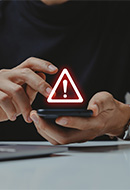Permissions in downloading apps
Applications: download in a secure manner
Nowadays there are applications for practically everything (instant messaging, online stores, banks, news, social networks...). From any of our devices we can have the service we want in just a few seconds. But are we doing so in a safe manner?
Applications: download in a secure manner.
Sometimes, we go so fast that when we want an application, we download it automatically and we do not realize that it is asking us for more information than necessary. Permissions that may be basic for its operation but that, also, sometimes, if they are not, can compromise the security of our devices.
Did you know that there are some applications that are not what they appear to be? Did you know that some request more permissions than necessary to access devices and obtain information or even take control of them?
Although the official stores (Play Store, App Store...) have controls that filter out the passage of "not so reliable" applications, they can always miss out on some. That is why it is very important to take a few seconds to review certain aspects before downloading to check whether it is a safe application or not.

Cybersecurity
Key pillars of cybersecurity at Iberdrola.

Phishing
Find out how to avoid being scammed via email, SMS or instant messaging.

Vishing
Find out what telephone scams involve and what types exist.

Smishing
Find out how text message scams happen.
Tips for safely downloading apps
How can you know if you have spyware on your mobile?
Spyware is a type of malicious software designed to infiltrate a device (such as a mobile phone, computer or tablet) and collect the user’s information without their knowledge or consent. It can gain access through the user downloading seemingly legitimate applications.
It can be tricky to detect spyware on your mobile phone, as it is a programme designed to operate under the radar. However, there are a few tips that can help you tell if your device has been compromised. Here are some of them:
Indications of possible spyware
What to do about possible spyware?
Source: Keeper Security.
Cases of breaches on mobile devices
Here are some real cases where users have had problems after downloading apps:
- Flashlight Led Widget. This app allowed users to install a powerful flashlight on their devices. What they did not know was that having this app on their devices allowed a virus to record user data, extract photographs, steal bank credentials and finally block the device.
- Fortnite. Cybercriminals took advantage of the popularity of this game to install Trojans on the device through fake apps.
- Avast. U.S. developers filtered an app imitating the software of one of the world's largest computer security companies, Avast Software. When users installed this app, the device became flooded with adverts that slowed down its functions.
-
CamScanner. This popular document scanning app was temporarily removed from download platforms after it was discovered that it had fallen into the hands of an advertising scam and contained malware that could display intrusive ads and subscribe users to services without their consent. The developers managed to remove the malware.
Apps like Pokémon Go. Following Pokémon Go’s launch and success, a number of fake apps imitating the game came out. However, these versions had malware that allowed attackers to take control of the infected devices.
These are just a few well-known cases, but the experiences are diverse and affect a wide variety of applications. Several reports agree that the most downloaded apps in the world are TikTok, Instagram, Facebook and Whatsapp, so being aware of download permissions on these platforms is especially important.

















